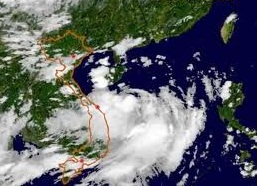
The climate tends to vary considerably from place to place because of differences in latitude and the marked variety of topographical relief. During the winter (dry season), extending roughly from November to April, the monsoon winds usually blow from the northeast along the China coast and across the Gulf of Tonkin, picking up considerable moisture; consequently the winter season in most parts of the country is dry only by comparison with the rainy or summer season.
 Annual rainfall is substantial in all regions and torrential in some, ranging from 1,200 to 3,000 millimeters (47.2 to 118.1 in). Nearly 90 % of the precipitation occurs during the summer. The average annual temperature is generally higher in the plains than in the mountains and plateaus. Temperatures range from a low of 5 °C (41 °F) in December and January, the coolest months, to more than 37 °C (98.6 °F) in April, the hottest month. Seasonal divisions are more clearly marked in the northern half than in the southern half of the country, where, except in some of the highlands, seasonal temperatures vary only a few degrees, usually in the 21–28 °C (69.8–82.4 °F) range.
Annual rainfall is substantial in all regions and torrential in some, ranging from 1,200 to 3,000 millimeters (47.2 to 118.1 in). Nearly 90 % of the precipitation occurs during the summer. The average annual temperature is generally higher in the plains than in the mountains and plateaus. Temperatures range from a low of 5 °C (41 °F) in December and January, the coolest months, to more than 37 °C (98.6 °F) in April, the hottest month. Seasonal divisions are more clearly marked in the northern half than in the southern half of the country, where, except in some of the highlands, seasonal temperatures vary only a few degrees, usually in the 21–28 °C (69.8–82.4 °F) range.
Vietnam is located in both a tropical and a temperate zone. It is characterized by strong monsoon influences and has a considerable amount of sunshine, a high rate of rainfall, and high humidity. Regions located near the tropics and in the mountainous regions are endowed with a temperate climate.
The monsoon climate also influences the changes of the tropical humidity. Every year there are 100 rainy days and the average rainfall is 1,500 to 2,000mm. The humidity ranges around 80%. The sunny hours are 1,500 to 2,000 and the average solar radiation of 100kcal/cm2 in a year.
Because Vietnam is affected by the monsoon, that is why the average temperature is lower than the other countries which are located in the same longitude in Asia. The annual average temperatures range from 22oC to 27oC.
In comparing with these countries, the temperature in winter is colder and in summer is less hotter in Vietnam.
Under influence of monsoon, and further because of the complicated topography, the climate in Vietnam always changes in one year, among years, or among areas (from North to South and from low to high).
In Hanoi capital, there are four distinct seasons: Spring, Summer, Autumn, and Winter. But it is able to be divided into two main seasons: the rainy season from May to September (it’s hot, heavy rain), and the dry season from October to April (it’s cold, little rainfall). The annual average temperature is 23.2oC, but in winter the average temperature is 17.2oC. The lowest temperature ever recorded was 2.7oC in 1955. The average summer temperature is 29.2oC, with the highest ever recorded being 42.8oC in 1926. On average, there are 114 rainy days a year with around 1,800mm of rainfall.
In Ho Chi Minh City, the climate is divided into two seasons, with the rainy season lasting from May to November. The average annual temperature is 27.5oC without winter, and yearly rainfall totals 1,979mm. Tourism is convenient for all 12 months of the year.
The climate in Vietnam differs greatly between north and south, though both regions experience monsoons. From November to April, the north is cool and dry, while May to October is hot and rainy. The central coast has a similar climate with cool, wet weather between December and February in the winter monsoon season. The seasons tend to begin a bit later in the south, which is hot and humid all year round, particularly from February to May, while the rainy season lasts from May to November. The Central Highlands have a similar climate to the south, but is somewhat cooler and temperatures can reach freezing in winter. The temperature in Hanoi can range from 63°F (17°C) in January, to 84°F (20°C) in June.
Vietnam's climate is as complex as its topography. Although the country lies entirely within the tropics, its diverse range of latitude, altitude, and weather patterns produces enormous climatic variation. North Vietnam like China, has two basic seasons: a cold, humid winter from November to April, and a warm, wet summer for the remainder of the year. Summer temperatures average around 70 degrees Fahrenheit (about 22 C), with occasional typhoons to keep things exciting. The northern provinces of Central Vietnam share the climate of the North, while the southern provinces share the tropical weather of the South. South Vietnam is generally warm, the hottest months being March through May, when temperatures rise into the mid-90's (low-30's C). This is also the dry season in the south, followed by the April - October monsoon season.
(84-63) 3 826042 – (84-63) 3 511142
No 54 Nguyen Dinh Chieu, Ham Tien Central Mui Ne Beach Binh Thuan Vietnam
523 To Hien Thanh District 10 Ho Chi Minh City Vietnam
Ha Long Halong City Quang Ninh Vietnam
A13 Hung Thong 2 Halong City Quang Ninh Vietnam




